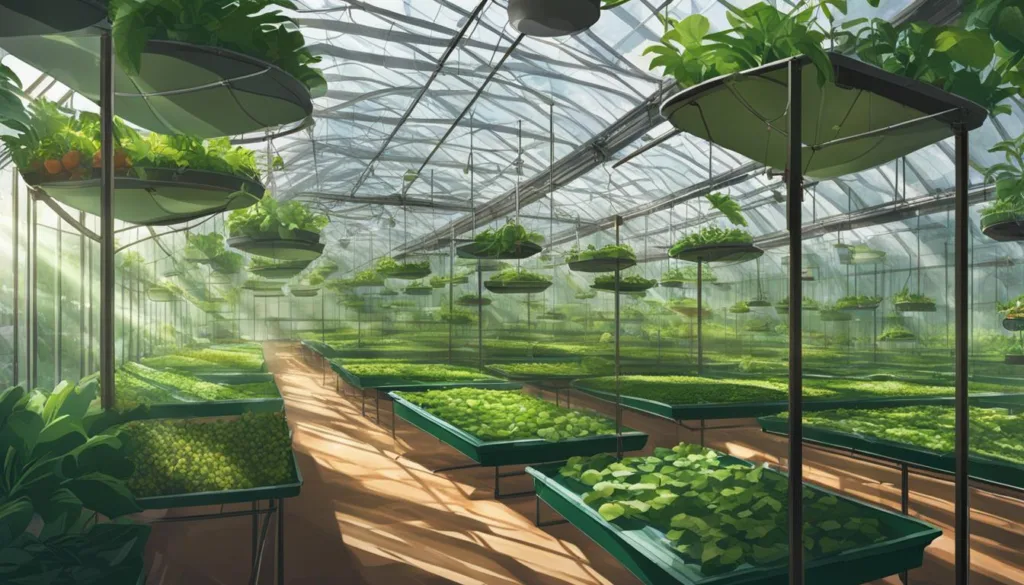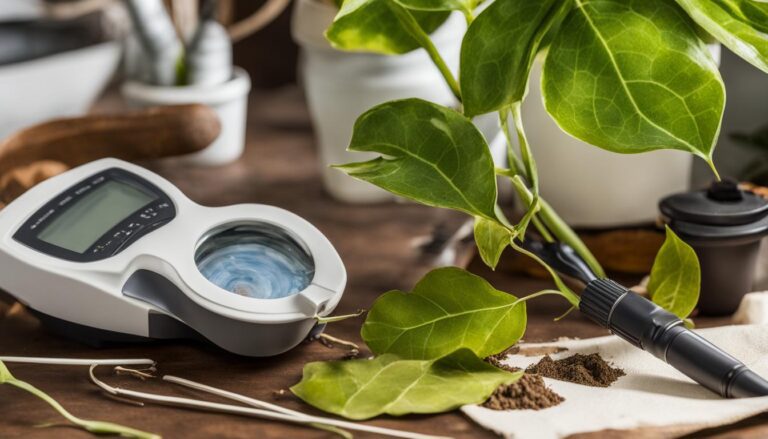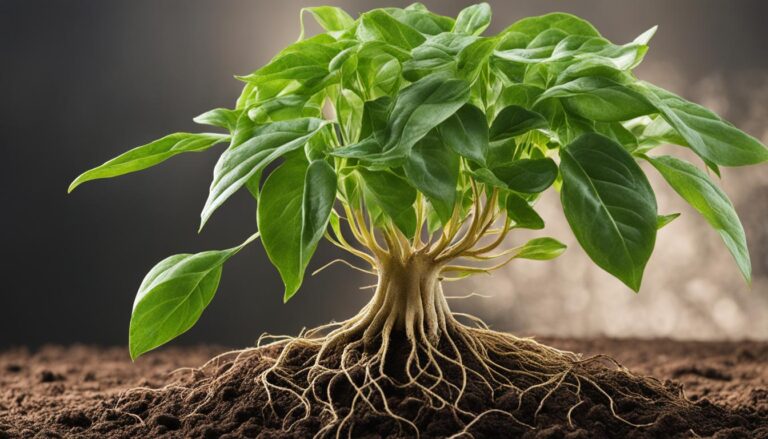
Adequate air circulation is crucial for the health and vitality of plants. It promotes transpiration, nutrient absorption, and strengthens root and stem growth. Additionally, good air circulation helps regulate temperature, dissipate excess humidity, and eliminate unwanted gases.
In this comprehensive guide, I will explore various strategies to improve air circulation for your plants, both indoors and in your garden. Let’s dive in!
Key Takeaways:
- Proper air circulation is essential for plant health and vitality.
- Airflow facilitates water movement, nutrient absorption, and disease prevention.
- Indoor plants benefit from fans, ventilation systems, and strategic placement near windows and doors.
- Garden plants thrive with unobstructed airflow and adequate spacing.
- Greenhouses require strategic fan placement for optimal ventilation, energy efficiency, and crop quality.
The Importance of Airflow for Plant Health
Adequate airflow is crucial for the health and growth of plants. It plays a vital role in promoting plant growth and overall plant health. Good air circulation ensures that plants receive the necessary oxygen for respiration and proper transpiration.
It facilitates the movement of water and nutrients throughout the plant, enhancing nutrient absorption and promoting healthy root development.
In addition to nutrient absorption, airflow helps to strengthen the plant’s root and stem growth. With proper air movement, plants develop stronger and more robust roots, which in turn support healthier overall growth.
Adequate airflow also helps control temperature and prevents the buildup of excess humidity, reducing the risk of fungal diseases and promoting optimal plant health.
Improved air circulation also aids in the elimination of unwanted gases that can accumulate around plants. By promoting air movement, these gases are effectively dispersed, ensuring a clean and healthy growing environment for plants.
Overall, by enhancing air circulation, you can create an optimal environment for plants to thrive, resulting in improved plant growth and vitality.
Benefits of Air Circulation for Plants:
- Promotes proper transpiration and nutrient absorption
- Strengthens root and stem growth
- Regulates temperature and dissipates excess humidity
- Eliminates buildup of unwanted gases
- Enhances overall plant health and vitality
The Impact of Air Circulation on Plant Health
| Aspect | Effect of Poor Air Circulation | Effect of Good Air Circulation |
|---|---|---|
| Transpiration | Reduced water movement through the plant | Proper water movement and nutrient absorption |
| Root and Stem Growth | Weaker and less developed roots | Stronger and more robust roots |
| Temperature Control | Unregulated temperature, leading to stress | Optimal temperature regulation for plant health |
| Humidity | Excess humidity, increasing risk of fungal diseases | Controlled humidity, reducing the risk of diseases |
| Gaseous Buildup | Accumulation of unwanted gases, hampering plant growth | Effective dispersion of gases, ensuring a healthy environment |
Strategies to Improve Air Circulation for Indoor Plants
When it comes to indoor plants, ensuring proper air circulation can be challenging due to limited airflow in enclosed spaces. However, there are several effective strategies you can implement to improve air circulation and promote healthier growth for your indoor plants.
One natural way to increase air circulation is by using fans or ventilation systems. These devices create movement and distribute fresh air throughout the room, providing a constant flow of oxygen to your plants. Additionally, opening windows and providing good ventilation can significantly improve airflow and prevent the buildup of stagnant air.
Strategically placing your indoor plants near open windows or doors can also enhance air circulation. This allows for natural air movement and helps in dissipating excess heat and humidity. Furthermore, regularly dusting and cleaning the leaves of your indoor plants can remove any debris or blockages that may hinder proper air circulation.
To summarize, improving air circulation for indoor plants is crucial for their overall health and vitality. By implementing strategies such as using fans, opening windows, and strategic plant placement, you can enhance air flow and create a more favorable growing environment for your indoor plants.
Different Strategies to Improve Air Circulation for Indoor Plants
| Strategies | Description |
|---|---|
| Use fans or ventilation systems | Create movement and distribute fresh air throughout the room |
| Open windows and provide good ventilation | Improve airflow and prevent the buildup of stagnant air |
| Strategic plant placement | Place plants near open windows or doors for natural air movement |
| Regularly dust and clean plant leaves | Remove debris and blockages that hinder air circulation |
Promoting Better Air Circulation for Garden Plants
Improving air circulation in your garden is crucial for the overall health and vitality of your plants. Adequate airflow helps prevent the buildup of stagnant air pockets and reduces the risk of diseases caused by excess humidity. By following these tips, you can enhance air flow and create a healthier growing environment for your garden plants:
- Remove larger vegetation: Trim or remove larger plants that may obstruct air movement in your garden. This will allow for better airflow and prevent the formation of stagnant air pockets.
- Consider fence height: If you have fences around your garden, make sure they are not too high as they can block the wind and restrict air circulation. Building shorter fences or using lattice structures can help promote better air flow.
- Provide adequate spacing: Properly space out your plants to prevent overcrowding, which can lead to poor air circulation. Each plant should have enough room for air to circulate freely around it.
- Choose the right location: Select a location for your garden that has good exposure to sunlight and adequate drainage. This will help promote better air circulation and create a favorable growing environment for your plants.
By implementing these strategies, you can optimize air flow in your garden and create a healthier growing environment for your plants. Remember, good air circulation promotes stronger root and stem growth, enhances nutrient absorption, and helps regulate temperature and humidity levels.
Benefits of Improving Air Circulation in the Garden
| Benefits | Description |
|---|---|
| Promotes plant health | Enhances nutrient absorption, strengthens root and stem growth, and improves overall plant vitality. |
| Prevents diseases | Reduces excess humidity and eliminates stagnant air pockets, lowering the risk of fungal and bacterial diseases. |
| Regulates temperature | Helps dissipate heat from the garden, preventing heat stress on plants and creating a more comfortable growing environment. |
| Improves pollination | Facilitates the movement of pollen, ensuring better pollination and higher yields for fruiting plants. |
| Enhances pest control | Improves air circulation can help deter pest infestations by making it more difficult for pests to settle and reproduce. |
By understanding the importance of air circulation and implementing strategies to improve airflow, you can create optimal growing conditions for your garden plants. With better air circulation, you’ll enjoy healthier and more productive plants throughout the growing season.
The Role of Fan Placement in Greenhouse Ventilation
When it comes to greenhouse ventilation, the placement of fans plays a crucial role in optimizing airflow and ensuring a healthy growing environment for your plants.
Proper fan placement can help distribute fresh air, regulate temperature, and dissipate excess humidity, all of which are essential for promoting plant growth and preventing diseases. By strategically positioning fans in your greenhouse, you can improve airflow and create an optimal environment for your plants to thrive.
One key consideration when determining fan placement is the size of your greenhouse. Larger greenhouses may require multiple fans placed strategically at different heights to ensure uniform airflow.
This helps to prevent stagnant air pockets and promotes air movement from floor to ceiling. By creating a consistent airflow throughout the greenhouse, you can enhance the distribution of essential elements, such as carbon dioxide, and maintain consistent temperature and humidity levels.
Another factor to consider when placing fans is the layout of your plants. Ensure that fans are positioned to provide adequate airflow to all areas of your greenhouse, including any hard-to-reach corners.
This will help prevent any potential hotspots or areas of poor ventilation that could be detrimental to plant health. By optimizing fan placement, you can create a well-ventilated greenhouse that provides the ideal growing conditions for your plants.
Fan Placement Recommendations
| Greenhouse Size | Recommended Fan Placement |
|---|---|
| Small (up to 100 sq. ft.) | One fan near the top of the greenhouse |
| Medium (100-500 sq. ft.) | One fan near the top and one near the bottom of the greenhouse |
| Large (500+ sq. ft.) | Multiple fans at different heights for uniform airflow |
By following these recommendations and considering the specific needs of your greenhouse, you can optimize fan placement and improve airflow for your plants.
Remember to regularly clean and maintain your fans to ensure optimal performance. With proper fan placement and ventilation, you can create a thriving greenhouse environment that promotes healthy plant growth and maximizes your crop yields.

Increasing Efficiency: The Role of Fan Placement in Greenhouse Ventilation
When it comes to greenhouse ventilation, maximizing efficiency is key to achieving optimal plant growth while reducing energy consumption. One crucial factor in achieving efficiency is the strategic placement of fans. By optimizing fan placement, you can improve ventilation, enhance airflow uniformity, and create a more sustainable and cost-effective greenhouse operation.
Properly positioned fans help to enhance airflow uniformity throughout the greenhouse, ensuring that fresh air is distributed evenly. This uniform airflow is essential for promoting proper carbon dioxide distribution, which is vital for photosynthesis and overall plant health. With improved air circulation, plants receive a consistent supply of fresh oxygen, ensuring better respiration and nutrient absorption.
In addition to promoting better air circulation, optimized fan placement can help regulate temperature and control humidity levels within the greenhouse.
By strategically positioning fans to circulate the air effectively, you can prevent stagnant air pockets and minimize the risk of high temperatures or excessive humidity. This not only creates a more comfortable environment for the plants but also reduces the reliance on artificial heating and cooling systems, resulting in energy savings.
Optimizing Fan Placement for Energy Savings
To optimize fan placement for energy savings, consider the following tips:
- Strategically position fans at different heights to create uniform airflow from floor to ceiling.
- Ensure fans are placed in areas where they can effectively circulate the air without obstruction.
- Consider the location of heat sources within the greenhouse and position fans accordingly to distribute the warm air evenly.
- Regularly monitor and adjust fan speed and direction to accommodate changing environmental conditions.
By implementing these strategies and optimizing fan placement, you can maximize the efficiency of your greenhouse ventilation system, improve air circulation, and create ideal growing conditions for your plants. This not only benefits plant health and growth but also contributes to a more sustainable and energy-efficient greenhouse operation.
Mastering Air Circulation: Exploring the Impact of Fan Placement in Greenhouse Settings
In order to optimize air circulation in greenhouses, it is essential to understand the impact of fan placement. By strategically positioning fans at different heights, you can create a uniform airflow that promotes optimal conditions for your plants to thrive. This includes distributing essential elements, regulating temperature, controlling humidity, and stimulating plant growth.
The goal of maximizing fan placement is to ensure that air movement is consistently flowing from the floor to the ceiling of the greenhouse.
This helps to evenly distribute fresh air, prevent stagnant air pockets, and eliminate any areas with poor ventilation. By doing so, you can enhance the overall greenhouse growing environment and create optimal conditions for your plants.
Optimizing fan placement for optimal airflow also contributes to better temperature and humidity control. By strategically positioning fans, you can regulate the temperature within the greenhouse, preventing it from becoming too hot or too cold.
Similarly, fans help to control humidity levels by dissipating excess moisture and preventing the buildup of unwanted gases. This is particularly important in greenhouse settings where humidity can lead to the growth of mold and other plant diseases.
| Fan Placement Benefits | Optimal Air Circulation | Temperature and Humidity Control |
|---|---|---|
| Promotes uniform airflow | Distributes essential elements | Regulates greenhouse temperature |
| Prevents stagnant air pockets | Stimulates plant growth | Controls humidity levels |
| Eliminates poor ventilation areas | Prevents mold and plant diseases |
By optimizing air circulation through fan placement, you can create an enhanced growing environment that maximizes the potential of your greenhouse. The increased airflow not only benefits the overall health and productivity of your plants but also contributes to a more efficient and sustainable greenhouse operation.
By understanding the impact of fan placement and implementing strategic positioning, you can master air circulation and create an optimal growing environment for your plants.

Key Takeaways
Proper air circulation is crucial for the health and vitality of plants. By strategically placing fans and optimizing airflow, you can improve plant health and maximize their growth potential. Whether you have indoor plants or a garden, these strategies can help you enhance air circulation and create a healthier growing environment.
In indoor settings, use fans or ventilation systems to create movement and distribute fresh air throughout the room. Opening windows and providing good ventilation also improves airflow. Dusting and cleaning the leaves of indoor plants can promote better air circulation.
In the garden, remove any vegetation that may block the wind and consider reducing the height of fences. Proper plant spacing and choosing the right location for your garden can significantly enhance air flow. These steps will help prevent stagnant air pockets and create a healthier growing environment for your plants.
For greenhouse owners, strategic fan placement is crucial for optimal airflow. By positioning fans at different heights, you can create uniform airflow and promote the movement of air from the floor to the ceiling. This helps distribute essential elements, regulate temperature, and control humidity, ultimately promoting healthier plant growth.
After reading this, check out our other articles on:
FAQ
Why is air circulation important for plants?
Air circulation promotes proper transpiration, enhances nutrient absorption, and strengthens root and stem growth. It also helps regulate temperature, dissipate excess humidity, and eliminate the buildup of unwanted gases.
How does air circulation benefit indoor plants?
Adequate airflow ensures proper water movement, facilitates nutrient absorption, prevents diseases, stimulates root growth, and provides fresh oxygen for respiration. It also helps control temperature and eliminates unwanted gases.
What strategies can I use to improve air circulation for indoor plants?
You can use fans or ventilation systems, open windows for fresh air, strategically place plants near windows or doors, and regularly clean plant leaves to improve indoor air circulation.
How can I enhance air flow for my garden plants?
Remove obstructions, such as larger vegetation or tall fences, to allow for better airflow. Ensure proper spacing between plants to prevent stagnant air pockets. Choose a location with good sunlight and drainage to promote better air circulation.
What is the role of fan placement in greenhouse ventilation?
Fan placement in greenhouses helps distribute fresh air, regulate temperature, and dissipate excess humidity. It is essential for optimizing airflow and creating a conducive environment for plant growth.
How can I increase efficiency in greenhouse ventilation through fan placement?
By strategically positioning fans, you can enhance airflow uniformity, improve carbon dioxide distribution, regulate temperature, and control humidity. This leads to energy savings by reducing reliance on artificial heating and cooling systems.
How does fan placement impact air circulation in greenhouses?
Proper fan placement ensures uniform airflow throughout the greenhouse structure, promoting essential element distribution, regulating temperature and humidity, and stimulating plant growth.
What are the key takeaways regarding air circulation and fan placement?
Adequate air circulation is crucial for plant health and can be achieved through strategic fan placement. Whether indoors, in the garden, or in greenhouses, improving air circulation enhances nutrient absorption, strengthens root and stem growth, and regulates temperature and humidity.






